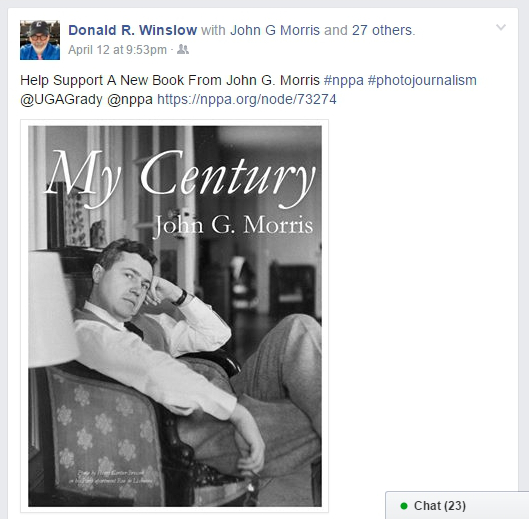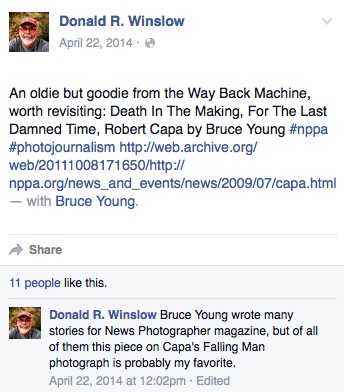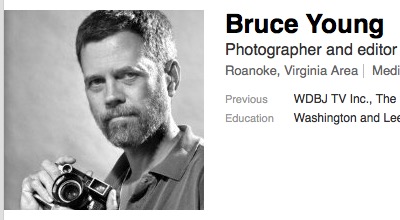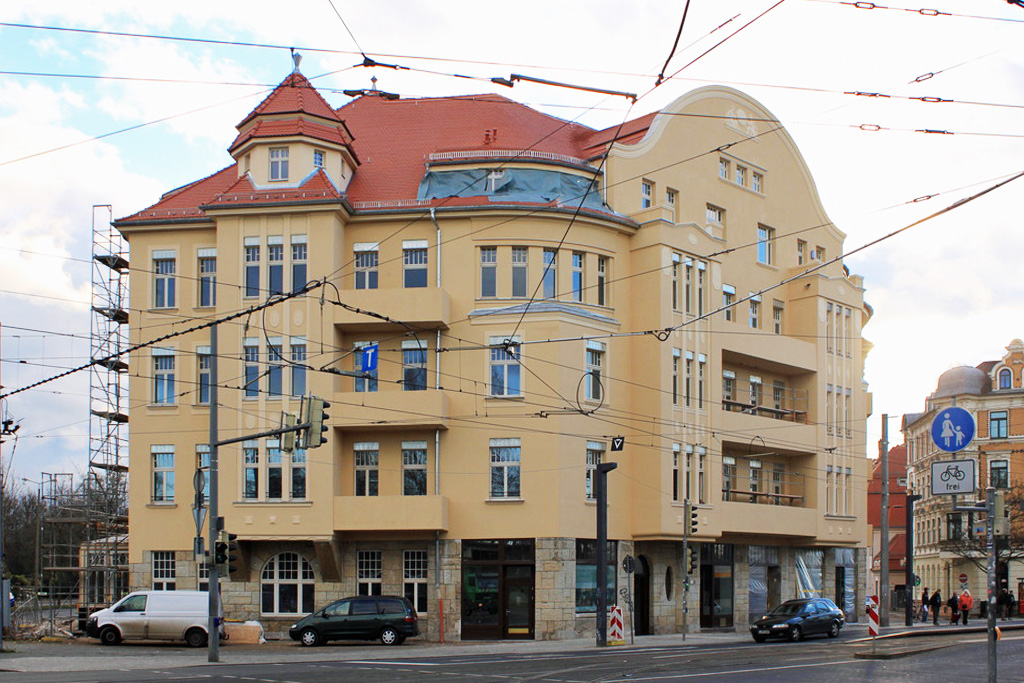“Investigative journalism is a lifetime of uncovering other people’s and government’s lies.” — Donald R. Winslow, National Press Photographers Association, Facebook, May 11, 2015
At the invitation of Rhonda R. Shearer, the founder, publisher, and editor-in-chief of the watchdog website iMediaEthics, I have prepared an analytical summary of the conflicts of interest, failures of full disclosure, and other journalistic excesses embedded in the attack on our project by the National Press Photographers Association (NPPA) in March 2015 — Bruce Young’s feature article “The Fog of War: D-Day and Robert Capa,” commissioned by NPPA’s then editor-in-chief Donald R. Winslow for publication in NPPA’s journal of record, News Photographer.
My scrutiny of Young’s article and NPPA’s actions now appears online, thoroughly reviewed and vetted for accuracy by the iMediaEthics team. I have titled it “Conflict of Interest, Cubed: Robert Capa, John Morris, and NPPA,” and you can access it here. The online version includes responses from Young, Winslow, Sean D. Elliott of NPPA’s Ethics Committee, and John G. Morris. You can judge for yourself their substance — or lack thereof.
As iMediaEthics has confirmed, Young’s article and its publication constitute a textbook case of breach of professional ethics — made all the more egregious by NPPA’s posturing as a leader in ethical matters. The issues involved go far beyond photojournalism. They arise independent of the subject and content of our Capa D-Day project — by which I mean that if our investigation concerned agricultural matters and the magazine represented some organization of agriculture professionals with comparable ties to prominent individuals and institutions in that industry, the same conflicts of interest and ethical breaches would result from an equivalent article. Thus this serves as a cautionary tale of journalistic malfeasance, with broad implications.
Through its blind allegiance to John Morris, NPPA brought this on itself. Surely it’s indicative of John Morris’s sphere of influence, even at his advanced age (97 when NPPA commissioned that article), that he effectively managed to persuade the administrative hierarchy of this professional organization to rally to his defense, and to breach professional ethics repeatedly in so doing.
 Launched in 2004, iMediaEthics offers the following statement of purpose:
Launched in 2004, iMediaEthics offers the following statement of purpose:
“iMediaEthics is a not-for-profit, non-partisan news site that publishes the latest media ethics news and investigations into ethical lapses. … [W]e hold the media accountable by examining concrete, measurable errors of fact and ethical breaches encountered in the press. iMediaEthics’ mission is unique and differs from other journalism sites in its focus on the knowable, the testable, the verifiable — in short, the facts. We have no agenda beyond advocating for factual, ethical reporting.”
•
With this article of mine readily available online, here’s another ethical question for my readers and NPPA’s members to ponder: What obligation do NPPA President Melissa Lyttle, Executive Director
Akili Ramsess, Ethics Committee chairperson Elliott, and others in the NPPA hierarchy now have to inform NPPA’s membership of this challenge to their ethics, published at a reputable website devoted to media ethics, one that thoroughly reviewed the article for accuracy?
Will Winslow or his successor send out tweets and Facebook posts about it forthwith? Will NPPA publish a notice of it, with a link to the iMediaEthics article? Will they add a link from Young’s article to the Robert Capa D-Day Project, so that the NPPA membership can judge whether its administration has engaged responsibly with published charges of unethical conduct? Or will they do their level best to keep the membership ignorant of this latest development?
•
(Note: Shortly before this article of mine appeared, Winslow was the subject of “The Uncertain Future of Photojournalism,” a flattering February 15, 2017 feature by James Estrin at the New York Times Lensblog column. Perhaps Estrin will follow up with a report on this iMediaEthics story, in which Winslow plays a central role.
For a savvy counterpoint to Winslow’s grumpy-old-man act in that piece, see Estrin’s February 18 follow-up, “Photojournalism’s Uncertain Future? She Begs to Differ,” a q&a with Leslye Davis, a young video journalist and photographer for the Times. See also my keynote address to World Press Photo 2000.)
Backpedaling with Bruce
While developing a list of sources so that iMediaEthics’ fact-checkers could put my report to their stringent accuracy test, I browsed the Facebook page of then NPPA editor-in-chief Donald Winslow, where I found an April 22, 2014 post recommending Bruce Young’s earlier piece on Capa and the “Falling Soldier” controversy. (Winslow advises accessing this article, “Death In The Making … For The Last Damned Time,” through the Internet Archive, apparently unaware that he has published it no less than twice at the NPPA site, where it was then and currently remains available: July 28, 2009 and November 12, 2012.)
Winslow holds Young’s earlier piece on Capa in high regard, praising it effusively in that Facebook post. Notably, however, by April 2014 — despite the “case closed” assertion of its headline — Young had largely revised his position on “Falling Soldier,” though not at NPPA’s website. He did so on November 14, 2013, in a post at his own blog, cat typing (which I came across while writing this article). Titled “The Photo that Never Dies,” it constitutes Young’s recanting of his previous position, in which he had proposed that we would never know the truth about the situation in which Capa made that photo and therefore could make no judgment of it — more of that equivocation which he has mastered.
In 2013, after listening to Capa’s then-recently unearthed radio interview with Tex and Jinx Falkenberg, in which Capa discusses the conditions under which he made “Falling Soldier,” Young wrote,
“Most of all, I think Capa was embarrassed by what he saw as [his own] personal cowardice, disgusted by his own profit from the situation, and finally trapped by the myth that rose up around the picture.
“So he finally, through a few reluctant retellings, assembled a more acceptable story probably based on his later experiences in combat, something that could be disposed of quickly with a minimum of questions, thus sparing him the need to dwell on his unpleasant and ambivalent feelings on the event. It’s a more public version of what we all do when trying to explain later some embarrassing mistake or unhappy argument, for example.”
This could easily apply, virtually verbatim, to what our research has uncovered about the making of Capa’s Omaha Beach exposures and the subsequent mythologizing of that episode. Too bad Young didn’t bring that insight to bear on our work when he got to it.
Young hasn’t had the integrity to retract his position on “Falling Soldier” at the NPPA site, where his article rests, in duplicate, unaltered. Nor did Winslow bother to mention in his Facebook post that Young had made a 180-degree turn since he published that piece.
Nor have either of them responded to the recent announcement by José Manuel Susperregui of research results proving that Capa’s “Falling Soldier” was staged by Capa at Cerro del Cuco, outside the town of Espejo, Córdoba, and that nobody died there on the day Capa made that picture. Looks like Young will have to eat his hat twice over on this one.
•
 This project has had its share of odd conjunctions and intersections. Chalk up another: WDBJ7-TV in Roanoke, VA, where Bruce Young now works, became the center of international media attention on August 26, 2015, when two of its employees, reporter Alison Parker and photojournalist Adam Ward, were shot dead while on live television. So Young, it seems, has become Ward’s replacement. What will his new colleagues make of his involvement in NPPA’s ethically challenged project?
This project has had its share of odd conjunctions and intersections. Chalk up another: WDBJ7-TV in Roanoke, VA, where Bruce Young now works, became the center of international media attention on August 26, 2015, when two of its employees, reporter Alison Parker and photojournalist Adam Ward, were shot dead while on live television. So Young, it seems, has become Ward’s replacement. What will his new colleagues make of his involvement in NPPA’s ethically challenged project?
Rearview Mirror
In fall 2016, in its behind-schedule Spring 2016 issue, the online journal Media Ethics published a different essay of mine, “Ethics in Photojournalism, Then and Now: The Case of Robert Capa.” In this piece I sketch the significant differences between the ethical environment in the fields of journalism and photojournalism at the time Capa did his work (1932-54) and that of our own time. I also indicate the importance of understanding the ethical context in which particular pictures got made when weighing the behavior at any given moment of photographers, picture editors, and publishers.
![]() This twice-yearly journal published its first issue in spring 1988. It describes itself thus:
This twice-yearly journal published its first issue in spring 1988. It describes itself thus:
Media Ethics is independent and inclusive. It is editorially eclectic and neither its sponsors, its editor, or its staff are responsible for its content. It strives to present and examine ideas, provide a forum for opinion and research articles on media ethics, as well as a venue for announcements and reviews of meetings, opportunities, and publications.
Capa D-Day Project at Revista Zum
 In September 2015 Francisco Quinteiro Pires, editor of a Brazilian journal, Revista Zum, asked me a set of questions about our Capa D-Day project. I replied, and they translated the Q&A into Portuguese and posted it at their website: “Um Robert Capa mais falível e humano: entrevista com A. D. Coleman.”
In September 2015 Francisco Quinteiro Pires, editor of a Brazilian journal, Revista Zum, asked me a set of questions about our Capa D-Day project. I replied, and they translated the Q&A into Portuguese and posted it at their website: “Um Robert Capa mais falível e humano: entrevista com A. D. Coleman.”
Since then, they have developed an English-language version of their site, where they have posted the original English-language version of this email dialogue: “A more fallible, more human Robert Capa: interview with A. D. Coleman.” Better late than never.
Pilgrim’s Progress
The list of shrines to the memory of Robert Capa has expanded. To the International Center of Photography in New York and the Robert Capa Contemporary Photography Center in Budapest add the newly restored “Capa Haus” in Leipzig, Germany.
On April 18, 1945, Capa was traveling with the 23rd Infantry Regiment as it advanced toward Berlin. In a second-floor flat at Jahnallee 61, Capa made a series of images of 21-year-old Raymond J. Bowman of Rochester, NY, manning a machine gun on the apartment’s balcony. As Capa photographed him in action, Bowman fell dead from a sniper’s bullet, with Capa continuing to photograph him in the moments after. Published in LIFE magazine’s “Victory” edition on May 14, 1945, this series became known as “The Last Man to Die.”
However, “their origins would have remained obscure had a group of Leipzigers interested in highlighting and preserving the city’s little-known Capa connection not discovered that a derelict 19th-century apartment block was where the photographer, embedded with the US army during the capture of the city, had taken the pictures,” according to the September 1, 2016 report by Kate Connolly for The Guardian.
“Learning that the building was destined for demolition four years ago,” the story continues, “the group set about trying to save it. And save it they have: following a €10.5m [$9.41m USD] refurbishment, including shoring up the foundations and replacing the balconies, the Capa Haus has been restored to its former glory. … Strips of Jahnallee have been renamed Bowman Strasse and Capa Strasse. In the elegant ground floor Cafe Eigler a permanent exhibition is dedicated to The Last Man series and other Capa pictures which tell the story of 18 April.”
As Chaucer told us in his prologue to The Canterbury Tales, April and pilgrimage go together well …
Our Project at YouTube
I’m in the process of aggregating at Youtube the videos posted there that pertain to our investigation. I’ve created a section of my own Youtube channel for that purpose, titled “The Robert Capa D-Day Project,” which you can access via this link. I’ve begun to annotate them, so that you’ll have some idea of the content, and the pertinent sections.
•
(For an index of links to all posts in this series, click here.)
•
This post sponsored by a donation from photographer Walter Dufresne.
•
 Special offer: If you want me to either continue pursuing a particular subject or give you a break and (for one post) write on a topic — my choice — other than the current main story, make a donation of $50 via the PayPal widget below, indicating your preference in a note accompanying your donation. I’ll credit you as that new post’s sponsor, and link to a website of your choosing. Include a note with your snail-mail address (or email it to me separately) for a free signed copy of my 1995 book Critical Focus!
Special offer: If you want me to either continue pursuing a particular subject or give you a break and (for one post) write on a topic — my choice — other than the current main story, make a donation of $50 via the PayPal widget below, indicating your preference in a note accompanying your donation. I’ll credit you as that new post’s sponsor, and link to a website of your choosing. Include a note with your snail-mail address (or email it to me separately) for a free signed copy of my 1995 book Critical Focus!
 Donate now and I’ll include a copy of The Silent Strength of Liu Xia, the catalog of the 2012-13 touring exhibition of photos by the dissident Chinese photographer, artist, and poet, currently in her sixth year of extralegal house arrest in Beijing. The only publication of her photographic work, it includes all 26 images in the exhibition, plus another 14 from the same series, along with essays by Guy Sorman, Andrew Nathan, and Cui Weiping, professor at the Beijing Film Academy.
Donate now and I’ll include a copy of The Silent Strength of Liu Xia, the catalog of the 2012-13 touring exhibition of photos by the dissident Chinese photographer, artist, and poet, currently in her sixth year of extralegal house arrest in Beijing. The only publication of her photographic work, it includes all 26 images in the exhibition, plus another 14 from the same series, along with essays by Guy Sorman, Andrew Nathan, and Cui Weiping, professor at the Beijing Film Academy.












Leave a Comment